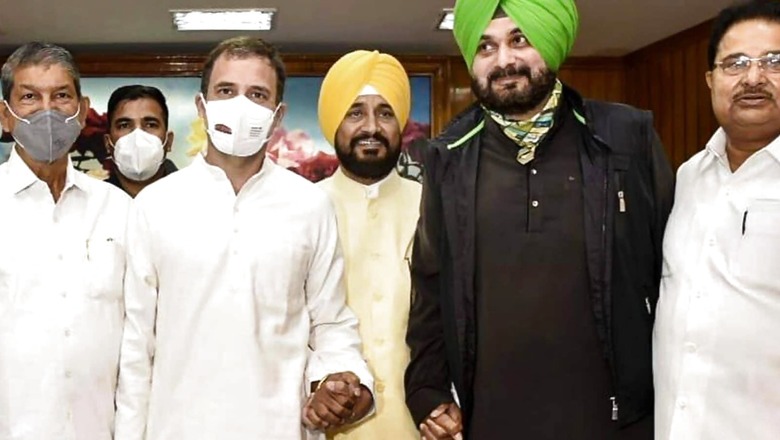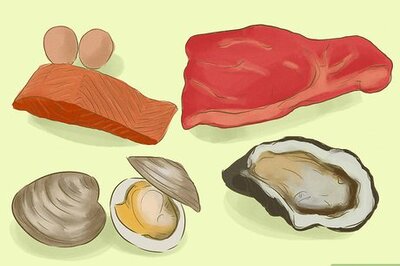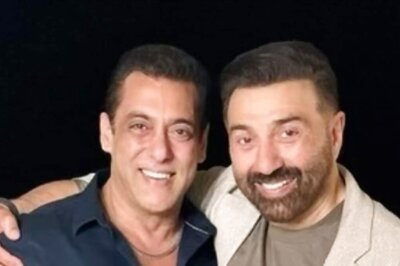
views
For the uninitiated, the Congress power tussle in Chandigarh was not just about mean one-upmanship but it was meant to drive home a larger point about the role of the state Congress chief when the party is in power.
Media optics and narrative focused on the Punjab Pradesh Congress Committee (PPCC) president Navjot Singh Sidhu’s rather brazen and unilateral decision to step down as state party chief when a newly formed cabinet allegedly did not adhere to noble principles of probity in public life, corruption-free governance, etc. All this was meant to showcase himself as a future chief ministerial candidate and dictate terms.
Following logjam, impasse and backroom maneuvering, Sidhu’s line of thinking prevailed and his resignation was withdrawn. For some news anchors and political commentators, it was an interference of sorts in the domain of the executive. But this is not the first time.
The tussle between the organizational and executive wings of the Congress had begun during the Jawaharlal Nehru era. After India gained Independence, the Congress had become everything—the state and the government. The ‘cold war’ between the haves (those who were in the government) and the have-nots (those in the party) frequently saw charges of corruption and indiscipline getting traded within the Congress Parivar.
Jawaharlal Nehru who had a towering personality chose to ignore All India Congress Committee (AICC) president Acharya Kripalani to ‘guide and advice’ the government, and the tail could not wag the dog. Nehru confronted another AICC chief Purushottam Das Tandon who had become party chief in 1950 and was known for his soft Hindutva views. Nehru humbled Tandon by asking the entire Congress Working Committee (CWC) to hand over resignations and ensured that Tandon would not dare to challenge him.
ALSO READ | Humiliated Jagan Reddy and Himanta Exacted Revenge on Congress. Captain Next?
Indira & Culture of Supreme Leader
Nehru’s daughter Indira too had several rounds of confrontation with party leadership. She was appointed prime minister by party bosses K. Kamaraj and S. Nijalingappa after Lal Bahadur Shastri died in office. But when the powerful Congress syndicate tried to dictate terms to the prime minister, she ensured that there would not be a place for them in the party. Since the Indira era, the party president has played second fiddle to the person occupying the top seat in the government.
At the Bhavnagar session of the AICC (1961), party president Neelam Sanjiva Reddy told party colleagues, “I would, therefore, suggest for consideration that people who have been in power, say for a period of ten years, voluntarily relinquish their offices and take up organizational work. Their wisdom, backed by a decade of administrative experience, should be available for the Congress organization so that they can lead the organization into better channels.”
Instead, by 1972, Indira Gandhi and her party were asking for a ‘committed bureaucracy’, instead of a neutral, professional workforce. Airing Indira’s thoughts, Shankar Dayal Sharma told the Kolkata AICC session in 1972, “The training, the background and the mental make-up of the entire bureaucracy may have served the purpose of colonial rulers, but surely, it does not inspire confidence in India today.”
Gradually, the Congress developed a culture of the ‘supreme leader’, in which loyalty to an individual leader became critical for survival. The presence of Sanjay Gandhi as an extra-constitutional authority further squeezed inner-party democracy and the right to dissent. Lloyd I. Rudolph and Susanne H. Rudolph, who authored In Pursuit of Lakshmi: The Political Economy of the Indian State, said that by the time Sanjay died in June 1980, the process of deinstitutionalization of the party system was complete. “He (Sanjay) died as he lived: daring, impetuous, contemptuous of the rules, a danger to himself and others … the effect of Sanjay’s leadership on the Congress was to deinstitutionalize it further by increasing its patrimonial features. By the time of his death, the party had become his and his mother’s bailiwick.”
ALSO READ | After Punjab Debacle, Congress Asks Its Leaders to ‘Talk More in Private, Less in Public’
The Balance Shifts
While the tussle was settled in favour of the former (read government) during the tenures of Nehru, Indira and Rajiv Gandhi, it fell on Sonia Gandhi to reverse the equation in 2004 when Congress-led UPA came to power. Her party managers worked on a strategy to ensure that the prime minister would be less powerful than her, no matter how competent s/he was.
In May 2004, Pranab Mukherjee had offered a remedy to ensure Sonia’s authority over the parliamentary wing of the party, which is the Congress Parliamentary Party (CPP). The CPP has a separate constitution, which is not the same as the AICC constitution. Until 2004, the CPP leader’s post was the highest but Clause 5 of the CPP constitution was amended to create the chairperson’s post. Under sub-clause ‘C’, the chairperson and not the CPP leaders would nominate the party leaders in both Lok Sabha and Rajya Sabha as well as deputy leaders and chief whips. The amended clause now reads: The chairperson shall have the authority to name the leader of the CPP to head the government, if necessary.
While Sonia and her team tried to establish the supremacy of the party during the UPA years, the Manmohan Singh regime saw mass induction of professionals at the cost of politicians. Kapil Sibal, Jairam Ramesh, Sam Pitroda, Montek Singh Ahluwalia, C. Rangarajan and dozens of others who were handpicked called the shots. Some of these professionals were in the cabinet, others in the Planning Commission (now Niti Aayog), National Advisory Council, Finance Commission, Prime Minister’s Scientific Advisory Council, Knowledge Commission or enrolled as interlocutors for behind-the-scenes talks with the US, Pakistan and China.
Thus, on the face of it, traditional politicians such as Sushil Kumar Shinde, Ghulam Nabi Azad, Kamal Nath, and Ambika Soni appeared to be in charge of big portfolios but in reality, their influence during the UPA years was far less. Their places were discreetly taken over by highly skilled professionals who shared Manmohan’s world vision. The beauty of the system was that unlike the resistance to Rajiv Gandhi’s sincere bid to bring professionalism in the party and the government, virtually nobody complained against Manmohan Singh.
During 2004-2014, UPA chairperson and Congress chief Sonia Gandhi spent most of her time intervening in crises and doing firefighting. As head of the National Advisory Council (NAC), she tried catering to rural and urban aspirations by blending the experience of NGOs with that of professionals at the NAC. But the limited success that NAC had was negated by a telling commentary on the efficacy of traditional Congress leaders.
The Philosopher-Politician Equation
The absence of the Congress’s intellectual capability to influence government and bureaucracy weakened the party. The Congress, at present, is in such disarray that even a suggestion that it is a philosopher (party) guiding the king (politician) would become a subject of ridicule.
Decades ago, Bhogaraju Pattabhi Sitaramayya, who lost the Congress president’s contest narrowly to Subhas Chandra Bose in 1939, with a poet’s flair had equated the Congress ideology closely with the Indian nation, establishing the ‘philosopher and the politician’ equation. He told AICC delegates at the Jaipur plenary in 1948: “The Congress is the service station of the life-giving ideology of the nation. The life-sustaining doctrines are pumped through the arteries of the government of the nation, where they become somewhat sullied in implementation and are returned to the Congress for purification. The ideology constantly discussed by the populace and constantly renovated as public opinion, is once again canalized by the Congress through the government in a renovated form, that is how the Congress and the government act and react upon each other … The Congress is really the philosopher, while the government is the politician. The latter has power and the former has influence.”
ALSO READ | Removing CM Baghel, Congress’ OBC Face in Chhattisgarh, Can Create More Problems for Party
In the present day Congress, the lofty relationship between the ‘philosopher and the politician’ is nowhere in sight. There is not even a semblance of inner-party democracy. The annual AICC sessions and the democratic elections of office bearers and the CWC has become a thing of the distant past.
It is ironic that both P.V. Narasimha Rao and Sitaram Kesri, despite their leadership limitations, tried in their own ways to usher in inner-party democracy by holding CWC and party polls in 1992 and 1997 respectively. Today’s party leaders and in-house historians have little or scant regard for those democrats. Sonia Gandhi, longest-serving AICC chief in the history of the party, has done little to streamline the party’s functioning, operating through ad hocism and expediency in spite of being the supreme leader of the party.
Sonia for the past 23 years has avoided constituting the party’s all-powerful Central Parliamentary Board (CPB). As per the Congress constitution, the powers to grant tickets for the state assemblies, Lok Sabha and Rajya Sabha lie with the CPB, but Sonia and Rahul Gandhi have usurped these powers without constituting the apex body.
The author is a senior journalist. The views expressed in this article are those of the author and do not represent the stand of this publication.
Read all the Latest News , Breaking News and IPL 2022 Live Updates here.




















Comments
0 comment